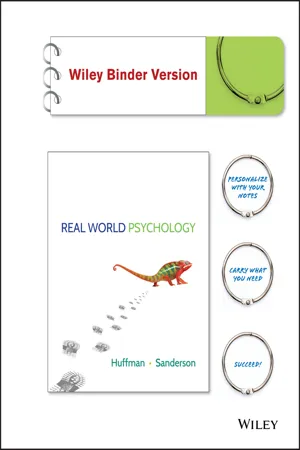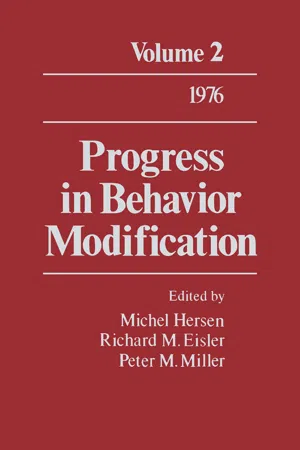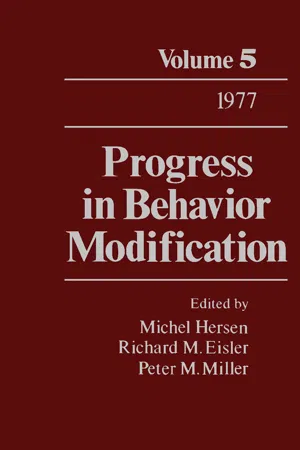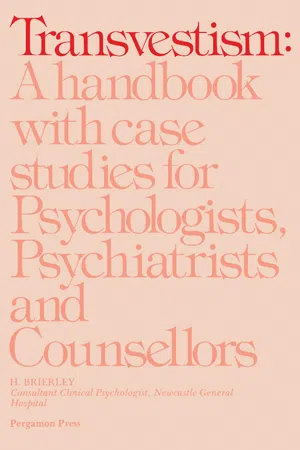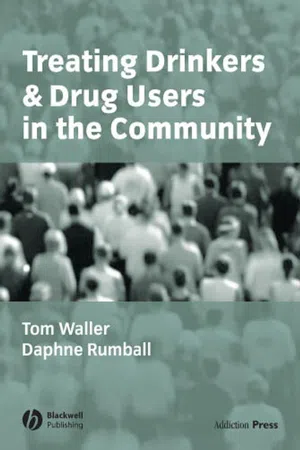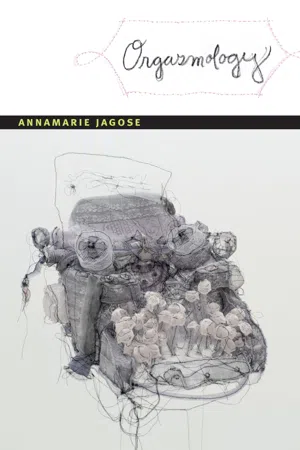Psychology
Aversion Therapy
Aversion therapy is a behavioral therapy technique that aims to reduce the frequency of undesirable behaviors by associating them with unpleasant stimuli. This form of therapy is based on the principles of classical conditioning, where the individual learns to associate the behavior with negative consequences, leading to a decrease in the behavior over time.
Written by Perlego with AI-assistance
Related key terms
1 of 5
11 Key excerpts on "Aversion Therapy"
- eBook - PDF
- Karen R. Huffman, Catherine A. Sanderson(Authors)
- 2013(Publication Date)
- Wiley(Publisher)
In contrast to systematic desensitization, Aversion Therapy uses clas- sical conditioning techniques to create anxiety rather than extinguish it. People who engage in excessive drinking, for example, build up a number of plea- surable associations with alcohol. These pleasurable associations cannot always be prevented. However, Aversion Therapy provides negative associations to compete with the pleasurable ones (Figure 13.9) . Aversion Therapy A type of behavioral ther- apy characterized by the pairing of an aver- sive (unpleasant) stimulus with a maladaptive behavior in order to elicit a negative reaction to the target stimulus. ©Syracuse Newspapers/D. Lassman/The Image Works FIGURE 13.8 VIRTUAL REALITY THERAPY Rather than use mental imaging or actual physical experi- ences of a fearful situation, virtual-reality headsets and data gloves allow a client with a fear of heights, for example, to have experiences ranging from climbing a stepladder all the way to standing on the edge of a tall building. FIGURE 13.9 Aversion Therapy The goal of Aversion Therapy is to create an undesirable, or aversive, response to a stimulus a person would like to avoid, such as alcohol. US (drug) + Neutral stimulus (alcoholic drink) CS (alcoholic drink without drug) UR (nausea) CR (nausea) 1 g n i n o i t i d n o c g n i r u D Someone who wants to stop drinking, for example, could take a drug called Antabuse that causes vomiting whenever alcohol enters the system. 2 g n i n o i t i d n o c r e t f A When the new connec- tion between alcohol and nausea has been classically conditioned, engaging in the once desirable habit will cause an immediate aversive response. © DRB Images, LLC/iStockphoto Q2 Operant Conditioning Shaping is a common operant conditioning technique used for bringing about a desired or target behavior. Recall from Chapter 6 that shaping provides immediate rewards for successive approximations of the target behavior. - eBook - PDF
- Kathleen Keller(Author)
- 2008(Publication Date)
- SAGE Publications, Inc(Publisher)
735 Taste Aversion Learning TASTE AVERSION LEARNING, or conditioned taste aver-sion, refers to a distaste or repugnance for a particular type of food due to a previous incident or stimulus with unfavorable consequences. Taste aversion learning, which tends to fall in the realm of psychology, can be attributed to certain molecular signaling and physio-logical pathways. The concept of taste aversion is based on a cause-and-effect relationship; a specific food can trigger memories of illness. In the case of obesity, taste aversion learning is a potentially useful tool for weight control and healthy eating choices. Taste aversion learning is a type of associative learning known as classical conditioning. Classical conditioning requires the presence of an uncondi-tioned stimulus that automatically evokes an uncon-ditioned response. The point of classical conditioning is to manipulate the relationship of the unconditioned response and stimulus and promote the onset of a certain conditioned response. In behavioral therapy the conditioned response will be more beneficial to the subject, in whatever area the therapy is seeking to address, and repetition will eventually lead to the removal of the more detrimental unconditioned re-sponse from the subject’s lifestyle. Aversion Therapy is a type of psychological therapy. The treatment occurs when a patient is exposed to a stimulus that is immediately followed by some kind of discomfort. The objective of Aversion Therapy is to condition the patient to associate the stimulus with something unpleasant that leads the patient to cease the targeted behavior. An aversive stimulus is an un-conditioned stimulus, and this stimulus produces an unconditioned response. With Aversion Therapy, the patient should learn to experience a new, conditioned response with each stimulus, and successful treat-ment will cause the compulsion to succumb to the former, unconditioned response to subside and even-tually disappear. - eBook - PDF
- Ronald Comer, Elizabeth Gould, Adrian Furnham(Authors)
- 2014(Publication Date)
- Wiley(Publisher)
Here, a man savours a drink just before the effects of a nauseating drug begin. Aversion Therapy a therapy designed to help clients to acquire anxiety responses to stimuli that they have been finding too attractive. BEHAVIOURAL THERAPIES 589 Operant Conditioning Techniques In operant conditioning treatments, therapists consist- ently provide rewards for appropriate behaviour and with- hold rewards for inappropriate behaviour. This technique has been employed frequently, and successfully, with hos- pitalized patients experiencing psychosis (Kopelowicz et al., 2007; Paul & Lentz, 1977; Ayllon & Azrin, 1965). When such patients talk coherently and behave nor- mally, they are rewarded with food, privileges, attention or something else they value. Conversely, they receive no rewards when they speak bizarrely or display other psy- chotic behaviours. Parents, teachers and therapists have successfully used operant conditioning techniques to change challenging behaviours in children, such as repeated tantrums, and to teach skills to individuals with autism or learning disabilities (Soorya et al., 2011; Spiegler & Guevremont, 2003). Rewards in such cases have included food, TV and trips out etc. Operant conditioning techniques typically work best in institutions or schools, where a person ’s behaviour can be reinforced systematically throughout the day. Often, a whole ward or classroom is converted into an operant conditioning arena. In many such programmes, desirable behaviour is reinforced with tokens that can later be exchanged for food, privileges or other rewards (Ayllon & Azrin, 1968). Pro- grammes of this sort are called token economy programmes. Behavioural techniques based on operant condition- ing have also been useful for depression (Lazzari et al., token economy an operant conditioning therapy programme in which partici- pants receive tokens (that can be traded for rewards) when they display desired behaviours. - eBook - PDF
- Michel Hersen, Richard M. Eisler, Peter M. Miller, Michel Hersen, Richard M. Eisler, Peter M. Miller(Authors)
- 2013(Publication Date)
- Academic Press(Publisher)
It was not merely the first theory of Aversion Therapy; the therapy itself was developed directly from the Pavlovian work on conditioning. Neither this important fact nor the popularity of the theory need deter us from taking a hard look at the basic assump-tions of the theory as applied to Aversion Therapy. One common variant of this theory proposes that aversion ther-apy is effective insofar as a conditioned emotional response (whether nausea or anxiety or any unpleasant autonomie reaction) is associ-ated with cues which elicit the unwanted behavior. Some authors have referred to this emotional response as a mini-neurosis. ,, Coun-ter-conditioning is assumed to take place in which the emotional response interferes with the execution of the behavior or causes the patient to avoid situations that elicit it. Quite apart from the ethical issue of the use of aversive stimuli, some people have questioned whether conditioning of unpleasant emotional reactions is ever a desirable treatment objective. For example, the elicitation of anxiety by members of the same sex or in situations where alcohol is drunk might be considered under other circumstances to warrant treatment in itself. However, as the evidence will show, this type of emotional conditioning seems to occur rarely. Although there is some clinical and experimental evidence to support the classical conditioning of emotions, there is a shortage of certain types of evidence (Hallam & Rachman, 1972b; Rachman & Teasdale, 1969). In particular, the few attempts to provide a psychophysiological basis for the theory have been almost entirely unsuccessful. In their discussion of chemical Aversion Therapy for alcoholism, Rachman and Teasdale concluded that the treatment effects are a consequence of the repeated pairing of the CS and the UCS [p. 29]. They argued that the evidence derived from the treatment of sexual disorders was less convincing. - eBook - PDF
- Michel Hersen, Richard M. Eisler, Peter M. Miller, Michel Hersen, Richard M. Eisler, Peter M. Miller(Authors)
- 2013(Publication Date)
- Academic Press(Publisher)
Their adoption of this more flexible approach resulted in the development of a new and useful treatment technique, aversion-relief therapy. D. Aversion-Relief Therapy Thorpe et al (1964) pointed out that one problem with behavior therapy arose from Eysenck's (1960) assertion that . . . p s y c h o -analysts show a preoccupation with psychological methods involving mainly speech, while behavior therapy concentrates on actual behav-ior as most likely to lead to the extinction of the unadaptive conditioned responses (p. 11). Thorpe et al considered that this assertion caused behavior therapists to go to great trouble and expense to reproduce the actual behavior to be extinguished, for example, obtaining female clothing to treat transvestites or suitable photographs of nude men and women to treat homosexuals. Thorpe et al considered that as the use of these photographs resulted in symbolizing relevant behavior, rather than reproducing it, it would be much simpler to symbolize the behavior with words. They pointed out that the resultant technique might not be classified as behavior therapy, but emphasized that it would render possible the treatment of any type of maladaptation. The previous experience of Thorpe et al with aversive therapy was the basis for another innovation in technique that was sub-sequently utilized widely. They had noted that each time a patient being treated with aversive therapy recognized by a signal that a treatment session involving unpleasant stimuli was finished, he expe-rienced great relief. They decided to attempt to utilize this relief in the treatment they developed, and therefore termed the treatment aversion-relief therapy. With aversion-relief therapy, the patient was shown a series of words or phrases every 10 sec. All but the last word or phrase related Behavioral Treatment in Homosexuality 325 to the behavior being treated, for example, homosexual or its synonyms. - eBook - PDF
- Karen R. Huffman, Alastair Younger, Claire Vanston(Authors)
- 2013(Publication Date)
- Wiley(Publisher)
To extinguish a driving phobia, the patient begins with images of sitting behind the wheel of a nonmoving car and ends with driving on a busy expressway at night in the rain. Behaviour Therapies 397 Making a nasty habit nastier • Figure 14.10 A person who wants to quit smoking could collect a jar full of (smelly) cigarette butts or smoke several cigarettes at once to create an aversion to smoking. Can you see how this Aversion Therapy uses classical conditioning? whenever alcohol is consumed. When the new connec- tion between alcohol and nausea has been classically con- ditioned, engaging in the once-desirable behaviour will cause an immediate negative response: Alcohol has now become a conditioned stimulus for nausea. Aversion Therapy is controversial. First, some re- searchers question whether it is ethical to hurt someone (even when the person has given permission). The treat- ment also has been criticized because it does not provide lasting relief (Seligman, 1994). One reason is that (in the case of the Aversion Therapy for alcoholism) people under- stand that the nausea is produced by the drug and do not generalize their learning to the alcohol. Operant Conditioning Techniques As we learned in Chapter 6, operant conditioning involves learning to associate a behaviour with its consequences. One operant conditioning technique for eventually bring- ing about a desired (or target) behaviour is shaping— providing reinforcement for successive approximations to the target behaviour. One of the most successful applica- tions of shaping and reinforcement has been with develop- ing language skills in children with autism. First, the child is rewarded for making any sounds, and later, for forming words and sentences. Shaping can also help people acquire social skills and greater assertiveness (Antony & Roemer, 2011). If you are painfully shy, for example, a behaviour therapist might first ask you to role-play simply saying hello to someone you find attractive. - eBook - ePub
Understanding Psychology for Medicine and Nursing
Insights and Applications
- Mohamed Ahmed Abd El-Hay(Author)
- 2019(Publication Date)
- Routledge(Publisher)
The final step is the systematic desensitization proper, this can be done either in imagery or in reality (in vivo exposure). At first, the lowest item in the hierarchy is confronted (in reality or in imagery). The patient is advised to signal whenever anxiety occurs, and is asked to relax at that time. After a few trials, the patient is able to control anxiety when the maximum anxiety-provoking stimulus can be faced in the absence of anxiety. In vivo exposure is more effective than simply imagining anxiety-producing situations, but it should come later for some clients who have severe intolerable symptoms.Flooding
The person is directly exposed to the phobic stimulus, while escape is made impossible. Decrease in anxiety and diminution of the phobic behavior result from prolonged contact with the phobic stimulus, under the therapist’s guidance and encouragement, and the therapist’s modeling behavior. This is used in the treatment of phobias and anxiety disorders, including post-traumatic stress disorder.Aversion Therapy
Aversion Therapy was used for the treatment of conditions which are undesirable but felt pleasant by the patient, e.g., alcohol dependence, and transvestism. The underlying principle is pairing of the pleasant stimulus with an unpleasant response, so that even in the absence of the unpleasant response, the pleasant stimulus becomes unpleasant by association. The unpleasant aversion can be produced by low voltage electric stimulus, or drugs (such as disulfiram in the case of alcohol dependence). Typically, 20–40 sessions are needed, with each session lasting about 1 hour. After completion of treatment, booster sessions may be given. Currently, the use of Aversion Therapy has declined sharply as it is felt that it may violate the human rights of the patient.Selective Reinforcement
Selective reinforcement is a technique designed to strengthen or increase specific desired behaviors, e.g., to complete assignments or to participate in class activities. Reinforcement of desirable responses can be accompanied by extinction of undesirable ones. It is used successfully in dealing with a broad range of childhood problems, including bed-wetting, aggression, tantrums, disruptive classroom behavior, poor school performance, and social withdrawal. Similar procedures have been used in treating autism, e.g., reinforcing socially appropriate behaviors such as looking other people in the eyes, or reducing inappropriate behavior, such as temper tantrums. When the reinforcement is withdrawn for some time in the case of undesired response, it is called time-out. Time-out is often used with therapy children with behavioral problems. - eBook - PDF
- C. G. Costello, Hugh L. Freeman(Authors)
- 2016(Publication Date)
- Pergamon(Publisher)
Aversion Therapy In Aversion Therapy, punishment of some sort is used to weaken the maladaptive response. In the aversion treatment of alcoholics, which is perhaps one of the better known of the behaviorist's techniques, alcohol and an emetine are given in such a manner that nausea quickly follows the drinking of the alcohol. Franks (1963) has noted that the reports of evaluation studies range from virtu-ally zero success to virtually 100 per cent success. He suggests that the failure in many studies may be due to: (1) The fact that some therapists have given the alcohol (conditioned stimulus— CS) after the nausea (unconditioned stimulus—US) has developed. It is difficult to establish backward conditioning, which is what one is trying to do when the US precedes the CS. (2) Little atten-tion has been given to the importance of the time interval between the presentation of the alcohol (CS) and the onset of nausea (US). (3) In some instances, the drug used to induce aversion may act as a central depressant, which makes conditioning difficult. He suggests, for this reason, that emetine hydrochloride is better than ampomorphine. Metzner (1961) has suggested that Aversion Therapy is likely to be unsuccessful permanently if the alcohol is used in states of severe anxiety which are not concomitantly treated. Wolpe (1958) has used the conditioned-aversion technique to cure a severe food obsession in a female patient, by administering an electric shock when she imagined the conflict-arousing food objects. 266 PSYCHOLOGY FOR PSYCHIATRISTS Max (1935) reported the breaking up of a homosexual fixation by faradic aversive conditioning (i.e. electric shock). Costello (1963a) has also used Aversion Therapy in the treatment of homo-sexuality. The patient, a young man in his early twenties, was admitted to the psychiatric unit for one week. On the first day, he rated a selection of fifteen pictures of nude, semi-nude and clothed males, in terms of their attractiveness to him. - eBook - PDF
Transvestism
A Handbook with Case Studies for Psychologists, Psychiatrists and Counsellors
- Harry Brierley(Author)
- 2013(Publication Date)
- Pergamon(Publisher)
Avoidance conditioning was particularly employed by Feldman and McCulloch (1965) on the basis that classical conditioning as normally used was not believed to be the most stable or rapid form of learning. Avoidance conditioning is a form of the wider learning model known as instrumental conditioning. This implies that the subject is able to exert some active control over the learning process. Effectively in Aversion Therapy it means that the patient is able to do something to avoid some of the stimuli or shocks if he opts for doing so. In classical condition-ing he receives all stimuli and shocks prescribed by his therapist. In avoidance conditioning practice the patient might be pre-sented with a picture of an article of clothing and it would be possible for him to avoid some of the risk of getting a shock by switching off the picture. It almost goes without saying that the patient learns to do so very rapidly and this avoidance is hard to extinguish. What is less persuasive is that this response of switching off the projector is specially relevant to real-life behaviour, like that of ceasing to wear high-heeled shoes, stable though it may be in the therapy situation. This criticism of avoidance conditioning is made by Rachman and Teasdale (1969) but answered by Feldman and MacCulloch (1971) in the empirical terms that it does generalise because the treatment is successful. Of course, this is an inadequate reply since the 178 Transvestism: A Handbook with Case Studies avoidance response may not be the operative part of the therapy at all. Feldman et al (1968) quote an attempt to im-prove on the face validity of avoidance conditioning by using apparatus where a mercury switch, mounted on head gear which the patient wore, served to switch off the pictures. Thus the active avoidance response would be looking away. In fact this is no more convincing since the elimination of homosexual behaviour must be a great deal more complex than a condi-tioned gaze avoidance. - Tom Waller, Daphne Rumball(Authors)
- 2008(Publication Date)
- Wiley-Blackwell(Publisher)
It provides a metaphor on which to base constructive thinking Discounting SSR LLR SSR LLR Figure 7.1 Smaller sooner versus larger later rewards. (Adapted from Vuchinich, R. E. & Tucker, J. A. (1998) Choice, behavioral economics, and addictive behavior patterns. In: W. R. Miller & N. Heather (Eds) Treating Addictive Behaviors , 2nd edn. Figure 1, p. 97. New York: Plenum Press. With permission from Kluwer Academic/Plenum Publishers.) Understanding Behavioural and Cognitive–Behavioural Approaches 145 than one of a disease process, and opens the door to a broad base of alternative interventions, the factors which govern their adoption, such as timing and availability, and their intrinsic value as well as their actual cost. In so doing it throws new light on ways to enhance the choice of e V ective treatment alterna-tives to substance use. Behavioural therapy Classical conditioning plays an important part in several potential therapeutic interventions. These include contingency management, covert sensitisation, Aversion Therapy and cue extinction. Contingency management is the use of operant conditioning as a therapeutic endeavour by provid-ing a system of rewards for behaviours that avoid substance use. It is particularly e V ective when used in the precontemplation and contemplation stages of change. Aversion Therapy attempts to associate unpleasant happenings, such as drug-induced vomiting or electric shocks, with substance use so that it is no longer rewarding. Although e V ective, it was not popular with the client group and led to an impaired relationship with caring professionals and therefore has been abandoned. It has been super-seded by covert sensitisation where the unpleasant associations are imagined rather than real. Cue de-sensitisation leading to loss of cue reactivity and eventual extinction removes the rewards that are associated with speci W c cues. A substance user is exposed to a drug-or drink-related cue without the follow-up of substance use.- eBook - PDF
- Annamarie Jagose(Author)
- 2012(Publication Date)
- Duke University Press Books(Publisher)
In particular, it is to suggest that close attention to the way orgasm functions in sexual-behavior-modification case studies of the mid-twentieth century goes to the heart of queer in-quiries into the nature of sexuality itself. Erotic Aversion Therapy: Two Case Studies from the 1960s Sometime in 1962 or 1963, a thirty-five-year-old man presented at Ban-stead Hospital, a psychiatric institution in Sutton, Surrey, England. He came to Banstead as a consequence of having read, a short time previ-ously, an article in a Sunday newspaper that referred to the successful Aversion Therapy that Dr. Basil James, the registrar of Glenside Hospi-tal in Bristol, had undertaken with a forty-year-old homosexual man. Exactly what the newspaper reported, or even which newspaper it was, has not been recorded, but an account of James’s work is available in an article he published in 1962 in the British Medical Journal . James presents his single case study as an unqualified success: his patient, exclusively homosexual, as indicated by his scoring a perfect 6 on the Kinsey scale, was judged “in all respects a sexually normal person” twenty weeks after the termination of his eight-day treatment. Some ten years earlier, this same patient had been hospitalized for three months, during which he had been subjected to psychotherapeutic treatment and doses of stil-boestrol, a drug intended to suppress his sexual appetites. Considering this regime “worse than useless,” he broke it off and, had he not been ad-mitted to the hospital a decade later, following a suicide attempt from a major barbiturate overdose, he would have been unlikely to have made himself available for further medical intervention. When the principles of Aversion Therapy were explained to him, he remained “frankly skepti-cal” but agreed nevertheless to receive the treatment. Despite his initial low expectations, after treatment he shared his doctor’s assessment of his cure.
Index pages curate the most relevant extracts from our library of academic textbooks. They’ve been created using an in-house natural language model (NLM), each adding context and meaning to key research topics.
